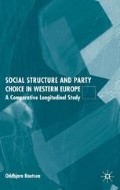Abstract
The urban and rural populations may vote for different political parties due to differences in political orientations and values, differences in general social structural characteristics (for example, education, income) and differences in political interests. The rural population is likely to vote for parties that articulate the interests of the rural and the agrarian population.
Access this chapter
Tax calculation will be finalised at checkout
Purchases are for personal use only
Preview
Unable to display preview. Download preview PDF.
Author information
Authors and Affiliations
Copyright information
© 2004 Oddbjørn Knutsen
About this chapter
Cite this chapter
Knutsen, O. (2004). Urban-Rural Residence. In: Social Structure and Party Choice in Western Europe. Palgrave Macmillan, London. https://doi.org/10.1057/9780230503649_4
Download citation
DOI: https://doi.org/10.1057/9780230503649_4
Publisher Name: Palgrave Macmillan, London
Print ISBN: 978-1-349-51652-0
Online ISBN: 978-0-230-50364-9
eBook Packages: Palgrave Political & Intern. Studies CollectionPolitical Science and International Studies (R0)

